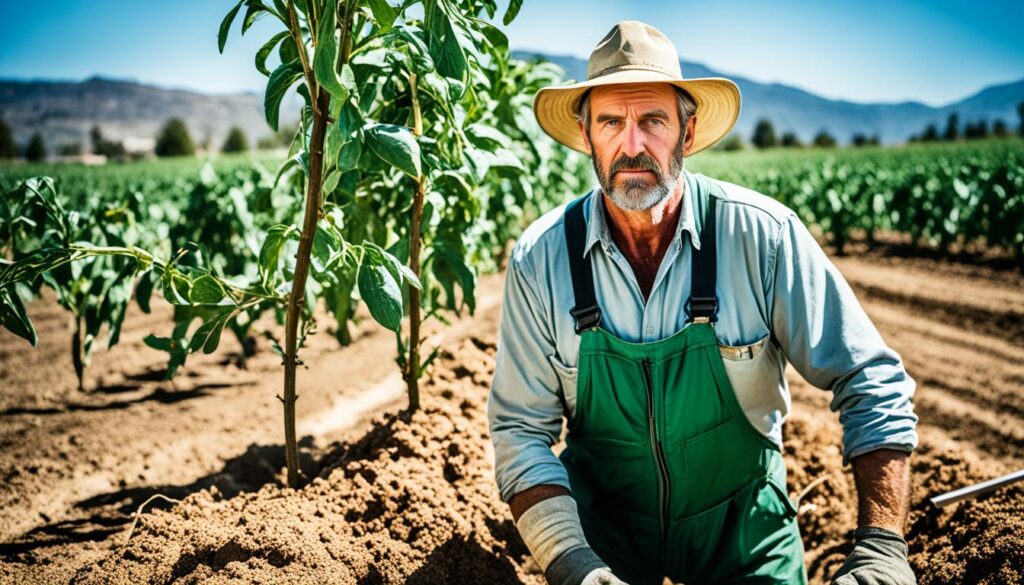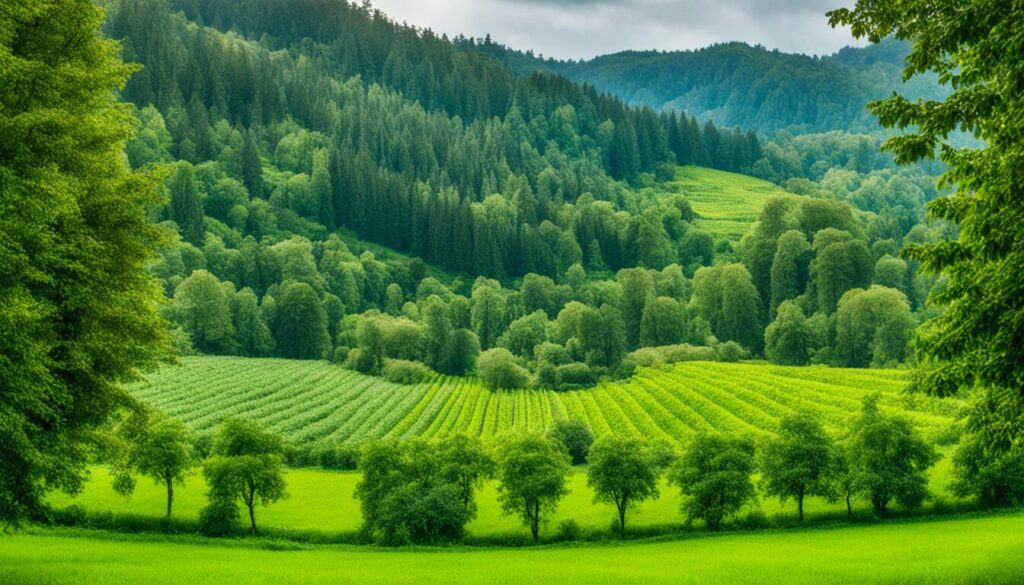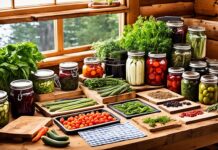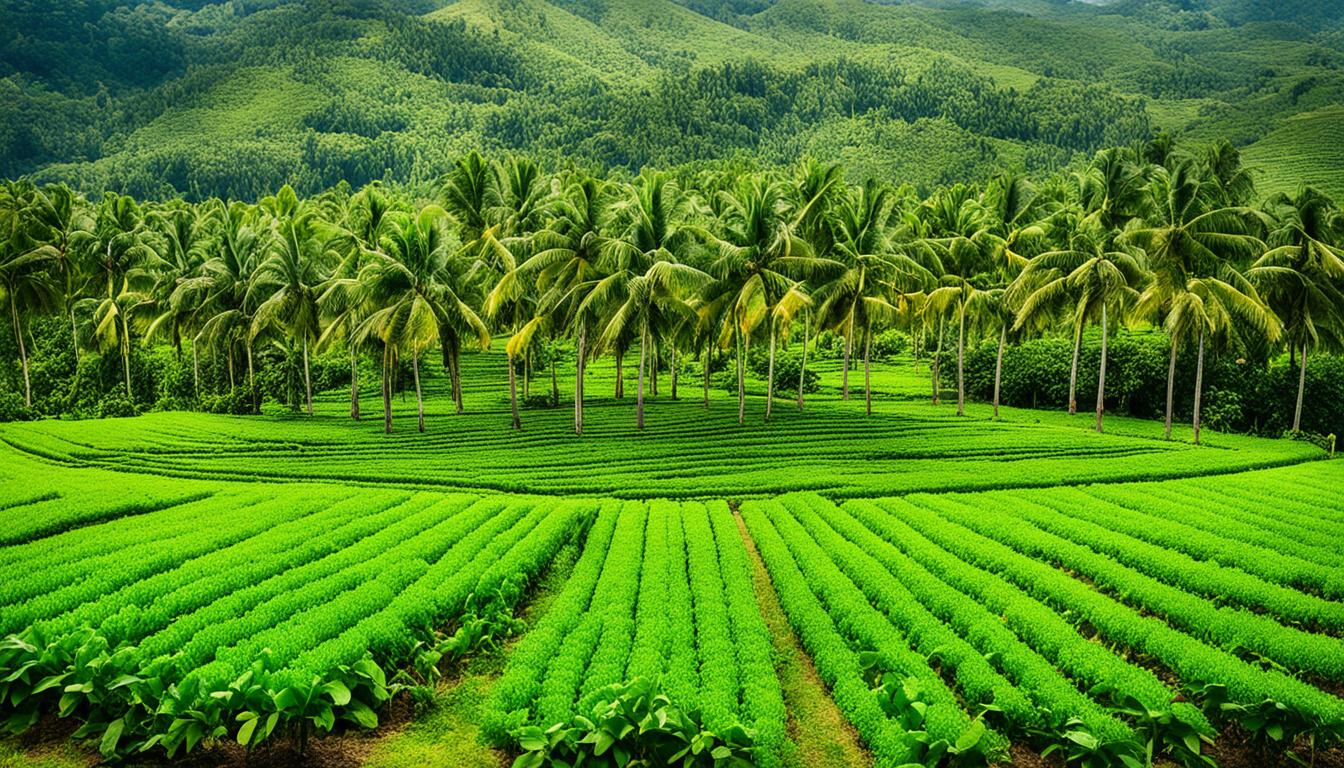Agroforestry is a way to manage land that mixes trees with crops or livestock. This method is becoming popular for solving big problems like food security, environmental harm, and climate change1. It also helps by making farms more diverse and strong1.
Agroforestry means planting trees in farms for specific reasons. This approach has many benefits, like protecting against wind and reducing soil loss. It also makes the soil better and helps with water use1. Alley cropping, a type of agroforestry, puts trees between crops. This helps with wind protection, stops soil from washing away, and makes the soil richer1.
Agroforestry is good for the planet and can make farmers more money1. It helps farmers grow different things, which lowers the risk of losing everything if one crop fails1. Trees in farms make the soil better, hold more water, and keep pests away. This means farmers can make more and spend less1.
Even with its benefits, agroforestry has challenges like needing money to start and finding the right tree and crop mix1. But, new ideas and working together are helping farmers use agroforestry successfully1. Groups like the World Agroforestry Centre help farmers learn and use agroforestry1.
As I learn more about agroforestry, I see its power to change farming for the better. It’s a way to use nature to help people and the planet2. Agroforestry can create jobs and improve life in rural areas2. It helps make food, fiber, and energy in a way that’s good for the earth2. The USDA is working on agroforestry with eight agencies to make it better2. Agroforestry works in many places, helping with different goals2. It has roots in Native American and early European farming, and is coming back after big weather events2.
Key Takeaways
- Agroforestry combines trees and crops or livestock to make farms diverse and strong.
- Practices like alley cropping offer many benefits, including wind protection and better soil.
- Agroforestry makes farming more sustainable by diversifying and reducing risks, and it can make money through ecosystem services.
- New ideas and teamwork are helping solve the challenges of starting agroforestry farms.
- Agroforestry fits with USDA goals, offering jobs, sustainable production, and climate resilience in rural areas.
What is Agroforestry?
Agroforestry is a way to manage land that mixes trees, crops, and livestock together. It’s about blending farming and forestry to make better use of land and improve the environment.3
Types of Agroforestry Systems
There are several types of agroforestry systems:
- Alley Cropping: Trees are planted next to crops to help each other out.
- Silvopasture: Trees and livestock work together to make the land more productive and healthy.
- Forest Farming: Special crops grow under the trees, like mushrooms or plants for medicine.
These systems help different parts of the land work together. This makes farming more sustainable and productive3.
Definition and Key Concepts
Agroforestry is all about mixing farming and forestry to help each other. It’s about making the most of nature’s interactions to grow food and protect the environment.4
“Agroforestry is a land-use system that integrates trees, crops, and/or livestock in a spatial arrangement or temporal sequence to leverage the ecological and economic benefits of their interactions.”
By mixing trees, crops, and animals, agroforestry aims for a more diverse and strong farming world. This approach helps farms face tough times better4.
| Agroforestry System | Key Features |
|---|---|
| Alley Cropping | Planting rows of trees alongside agricultural crops |
| Silvopasture | Integrating trees with livestock grazing |
| Forest Farming | Growing specialty crops beneath a forest canopy |
Benefits of Agroforestry
Agroforestry mixes trees with crops for the environment’s good. It helps with sustainable land use5. It boosts soil health, saves biodiversity, stores carbon, and manages water better5.
Soil Health and Fertility
Agroforestry keeps soil healthy5. Trees help stop erosion, improve water flow, and add organic matter. This makes the soil better and more fertile5. Trees, crops, and soil work together to cycle nutrients, making the soil even more fertile6.
Biodiversity Conservation
Agroforestry creates a mix of habitats for many plants and animals5. This helps protect biodiversity5. It gives homes, food, and places to breed for many creatures, like pollinators and endangered species6. Agroforestry keeps the land’s balance and makes it more resilient5.
Carbon Sequestration and Climate Mitigation
Trees in agroforestry systems take in a lot of carbon dioxide5. This helps fight climate change by storing carbon for a long time6. Agroforestry can also make farmers money through carbon offset programs6.
Water Management
Agroforestry helps with water, making it better for the land5. Trees reduce evaporation and control heavy rain, making water use more efficient5.
Agroforestry uses trees, crops, and the environment together to solve big environmental problems5. It’s great for farmers, policymakers, and those who care about the environment6.
Economic and Social Impacts
Agroforestry systems bring big economic and social benefits. They mix trees, crops, and livestock together. This mix helps farmers make more money and lowers the risk of losing everything due to market changes or bad weather7. By selling different products like timber, fruits, and livestock, farmers make more money and work smarter7.
Diversified Income Streams
Agroforestry lets farmers earn from many sources. They can sell timber, fruits, nuts, and more. Plus, they make money from livestock and crops8. For example, agroforestry can bring in about Rs23916 (US$598) to Rs31466 (US$786) a year, more than the usual Rs2250 (US$56) to Rs3000 (US$60)8. This variety helps farmers stay stable and strong against market ups and downs.
Increased Productivity
Agroforestry makes farms more productive. Most farmers use a mix of crops, trees, and livestock8. This approach uses land, water, and resources better. Agroforestry is great for many things like storing carbon, controlling erosion, and improving food production9.
Resilience and Community Development
Agroforestry helps rural communities by creating jobs and making food more secure7. It brings people together by offering economic chances and improving local life7. Things like festivals, moving, and talking to others make agroforestry good for farmers8.
“Agroforestry is promoted for carbon sequestration, soil erosion and runoff control, nutrient and water cycling, socio-economic benefits, and enhanced agricultural productivity.”9
Environmental Restoration and Conservation
Agroforestry is key in fixing damaged lands and saving nature. It mixes trees with farms to heal the earth, make soil rich, and bring water to dry places10. This mix helps bring back nature and protect many plants and animals11. Trees in farms also clean the air by shading the ground, cooling it, and making the environment better10.
In places like the Northeast, agroforestry uses riparian buffers, windbreaks, and more to help the environment10. These methods help fight climate change by storing carbon, cutting down on greenhouse gases, and using less fuel on farms10. Silvopasture, mixing trees with pastures, is especially good at fighting climate change10.
But, we must manage trees carefully to avoid harming nature and making climate change worse11. Agroforestry in the Northeast and elsewhere helps farmers and land managers fight climate change while also boosting their farms and protecting nature10.
The International FTA-Kunming Conference in June 2021 brought together nearly 400 people to talk about the power of trees in farming and conservation12. They discussed how trees help with sustainable farming, protect biodiversity, and support the goals of the CBD12.
| Agroforestry Practice | Potential Benefits |
|---|---|
| Riparian Forest Buffers | Improve water quality, reduce soil erosion, and provide wildlife habitat |
| Windbreaks | Reduce wind erosion, protect crops and livestock, and enhance microclimate |
| Silvopasture | Integrate trees, forage, and livestock for improved productivity and climate change mitigation |
| Alley Cropping | Increase crop yields, improve soil fertility, and provide additional income streams |
| Forest Farming | Cultivate high-value specialty crops in forested environments |
Agroforestry is key to reaching global and European biodiversity goals, as shown by recent studies11. It makes organic farming more sustainable and supports eco-friendly farming methods11. In places like Cameroon, agroforestry helps those who rely on cocoa for their income, showing the importance of training farmers11.
“Agroforestry offers a nature-based solution to environmental restoration and conservation, integrating the best of agriculture and forestry for a sustainable future.”
Agroforestry helps fix damaged lands, protect nature, and fight climate change by adding trees to farms10. As we face big environmental challenges, agroforestry is a strong way to solve these problems and help farmers and communities.
Agroforestry Practices and Integration Techniques
Agroforestry combines trees, crops, and livestock in ways that help each other out13. This approach shows how trees and crops can work together for a sustainable and productive farm. It’s all about making the most of the land.
Alley Cropping
Alley cropping puts trees right next to crops. This helps with wind protection, stops soil from washing away, provides shade, and homes for good bugs. It also adds organic stuff to the soil13. Trees with a low “leaf area index” let enough sunlight to the crops14. Plus, cool-season crops handle tree shade pretty well14.
Silvopasture
Silvopasture mixes trees with grazing animals. It gives animals shade, helps with carbon storage, boosts nature’s variety, and stops soil from washing away13. About 25% to 60% shade is best for silvopasture, which means 100 to 450 trees per acre14. This method includes rotating animals, using different plants for better food and bug control, and keeping trees safe from animals before they’re harvested14.
Forest Farming
Forest farming grows crops under trees, making the most of the land and creating a good place for plants to grow13. Food forests have many layers of plants, like in early forests14. Adding plants that attract bugs and predators helps with pests in food forests14.
Choosing the right plants for agroforestry means thinking about the soil, climate, and the specific spot you’re using14.
“Agroforestry can be an effective strategy for sustainably managing land and natural resources, providing economic, social, and environmental benefits to communities.”
| Agroforestry Practice | Key Benefits |
|---|---|
| Alley Cropping | Windbreaks, erosion control, shade, habitat for beneficial insects, soil enrichment |
| Silvopasture | Shade for livestock, carbon sequestration, biodiversity enhancement, soil erosion prevention |
| Forest Farming | Optimized land use, favorable growing conditions for shade-tolerant crops |
These agroforestry methods show how trees, crops, and livestock can work together for a better farm13. They offer economic, social, and beauty benefits, making them more appealing to farmers13.
Challenges and Solutions
Agroforestry systems come with their own set of challenges for farmers. The high initial costs and the need for more labor can make it hard to start. Choosing the right mix of trees and crops is also tricky15. Not having enough land, cutting down trees without a plan, and lack of government support can also slow down these sustainable practices15.
Barriers to Adoption
Uncertainty about land rights and policies is a big hurdle for agroforestry. Farmers might not want to invest in trees if they’re not sure they’ll keep the land15. Some farmers see agroforestry as too hard and time-consuming, which stops them from trying it out15.
Innovative Technologies and Approaches
New solutions and tech are coming to help with agroforestry challenges16. Programs and training for farmers, supported by groups like the World Agroforestry Centre (ICRAF), are key16. New tools, tree breeding, and precision farming tech are making it easier to manage these systems16.
Working together is key to beating these hurdles and making agroforestry more common15. By tackling the problems and using new ideas, we can speed up agroforestry adoption. This leads to big wins for the environment, economy, and communities1516.

| Challenges in Agroforestry Adoption | Innovative Solutions and Approaches |
|---|---|
|
|
“Addressing the challenges and implementing innovative solutions is crucial for accelerating the adoption of sustainable agroforestry practices.”
Role of Organizations and Initiatives
Many groups and projects are key in spreading and supporting agroforestry practices. The World Agroforestry Centre (ICRAF) leads the way globally. It does research, offers resources, and works with farmers and others to improve agroforestry17. ICRAF aims to create new technologies, share knowledge, and solve challenges in the agroforestry field.
National and regional agroforestry groups also play a big part. They share information, offer technical help, and talk about policies to make agroforestry easier to adopt17. These efforts help get past the hurdles of agroforestry, like it being new, not well-known, and crossing different areas17.
Working together is key for success. Federal agencies, universities, and private companies need to team up17. This teamwork can tackle the lack of agroforestry research and action, which is a big issue17.
Worldwide, there’s a growing interest in agroforestry because of its focus on taking care of the land and protecting the environment17. Actions like adding an agroforestry section to the 1995 farm bill have been suggested. Also, creating a USDA committee and a national agroforestry council could help more people adopt agroforestry practices17.
| Agroforestry Practices | Description |
|---|---|
| Windbreaks | Trees or shrubs planted in rows to protect crops, livestock, and buildings from wind |
| Alley Cropping | Planting rows of trees or shrubs with annual crops in the alleys between the rows |
| Tree/Pasture Systems | Integrating trees or shrubs with livestock grazing |
| Living Snowfences | Using trees or shrubs to trap snow and prevent drifting |
| Riparian Forest Buffers | Trees and shrubs planted along waterways to protect water quality and provide wildlife habitat |
| Tree/Specialty Crop Systems | Growing high-value specialty crops, such as fruits or nuts, in combination with trees |
| Forest/Specialty Crop Systems (Forest Farming) | Cultivating high-value specialty crops, such as ginseng or mushrooms, in forested areas |
| Wildlife Habitat | Planting trees, shrubs, and other vegetation to provide food and shelter for wildlife |
| Fuelwood Plantations | Growing trees specifically for the production of firewood or other bioenergy |
These agroforestry practices show many ways to mix trees and crops for better land use17. With the help of groups and projects, we can make these agroforestry systems work. They’re good for the planet, communities, and local economies.
Policy and Regulatory Considerations
The success of agroforestry depends a lot on the policies and rules in place. These rules help farmers grow trees and crops together. They also offer money help for starting agroforestry and solve land ownership problems18.
The USDA Agroforestry Strategic Framework sets goals for agroforestry in the U.S. It aims to reach out to landowners, do research, and use agroforestry info and tech18. Programs like those from the USDA Natural Resources Conservation Service also push farmers to use agroforestry18.
Having clear policies and rules that see the many good things about agroforestry is key. These systems lock away a lot more carbon than just farming crops alone. They also give clean water, use less fertilizer and pesticides, are more resilient, and make more money per acre19.
But, agroforestry doesn’t make money right away like crops do, which can slow down its use. There’s not much public money for agroforestry because funds don’t last long19. Getting land is also hard for agroforestry19. To help, we should fund agroforestry research, give more money for outreach and training, offer more ways to finance it, add agroforestry to federal programs, and make it easier to get land for agroforesters19.
With the right policies and rules, we can make agroforestry work better. This can help solve big environmental and economic problems. It will make farming more sustainable and strong1819.
Agroforestry: Integrating Trees and Crops for Sustainability
Agroforestry is a way to make farming sustainable by mixing trees, crops, and livestock together. This approach helps farmers get more from their land. It’s good for the environment, food security, and fighting climate change.
Agroforestry makes soil better by adding organic matter and storing carbon. This helps plants and animals grow, which is good for nature and our planet20.
The Nature Conservancy is starting a 5-year project to boost agroforestry in 30 U.S. states21. With $60 million from the USDA, they aim to plant 30,000 acres of agroforestry. This could help reduce CO2 emissions by a lot if more farmers do it21.
Agroforestry also helps farmers by making their farms more productive and secure20. It gives farmers more ways to make money and helps them grow food for their families. It also helps women and young people by teaching them new skills20.
Agroforestry is a key solution for today’s big challenges. By combining trees and crops, we can make farming better for everyone and the earth212022.

| Key Benefits of Agroforestry | Quantified Impact |
|---|---|
| Soil Carbon Sequestration | Agroforestry can sequester 2 to 4 tons of CO2 per acre per year21. |
| Increased Crop Yields | Agroforestry can increase crop yields by 50%22. |
| Soil Organic Carbon Increase | Transitioning from agriculture to agroforestry can increase soil organic carbon by 34% on average22. |
| Financial Diversification | Agroforestry can provide a financial incentive to sequester carbon, contributing to financial diversification and security for farmers22. |
“Agroforestry transforms landscapes into more resilient ecosystems, enhancing soil quality, supporting biodiversity, and providing economic benefits to farming communities.”
By using agroforestry for sustainability, we can make farming better for the planet and people. Agroforestry is a key solution for today’s big challenges. It’s time to pay more attention to it.
Climate Resilience and Adaptation
Agroforestry systems are key to making farms more resilient to climate change. They mix trees, crops, and livestock in a way that helps fight climate change23. These systems store a lot of carbon dioxide, which helps fight climate change24. They also offer many products, making farmers less dependent on one income source and more resilient23.
Agroforestry uses like windbreaks and riparian buffers help manage water, prevent soil erosion, and create better microclimates23. This makes farms more resilient to climate change. By using agroforestry, farmers and communities can adapt and stay sustainable as the climate changes23.
However, not knowing how to set up and manage agroforestry can stop people from using it to fight climate change23. World Agroforestry (ICRAF) and partners have made three tools to help agroforestry spread in ASEAN Member States (AMS)23. The “Agroforestry for Climate Resilience” guide gives advice on how to design and manage agroforestry to handle extreme weather23.
This guide is for extension workers, farmers, and others who work with agroforestry in ASEAN Member States23. It focuses on adapting to climate change by using agroforestry in different farms. This effort aims to grow resilient agroforestry systems and make farms more resilient to climate change in the region23.
Climate change is causing more heat, unpredictable rain, longer droughts, and other issues in many places23. Agroforestry can make farms and landscapes more resilient to these problems23. It helps with food production and protects the environment23.
Studies show that agroforestry can improve farming in changing climates24. In West Africa, agroforestry has made farming better for crops like millet and cowpea24. In the Mediterranean, it affects soil carbon levels24.
In the U.S., agroforestry can store a lot of carbon dioxide each year25. It can also boost crop yields by up to 56 percent, according to the USDA25. Programs like the Conservation Stewardship Program and Environmental Quality Incentives Program support agroforestry projects25.
By using agroforestry, farmers and communities can fight climate change and make their farms more sustainable232425.
Long-term Impacts and Sustainability
Agroforestry systems offer long-term benefits for farmers and the planet1. They mix trees, crops, and livestock to improve soil health and protect biodiversity1. Over time, these practices can fix damaged lands, clean water, and make farms more resilient and diverse1.
Agroforestry also makes farming more financially stable by diversifying income and using land better1. It brings people together, sharing knowledge and building strong communities1. As we see the effects of agroforestry, it shows how it can change farming for the better.
| Agroforestry Benefits | Impact |
|---|---|
| Soil Health and Fertility | Agroforestry practices like alley cropping add organic matter, helping with sustainable land use1. |
| Biodiversity Conservation | Agroforestry increases productivity, brings back ecosystems, and helps more species1. |
| Economic Sustainability | Agroforestry makes farming more sustainable by offering more income sources and using land well1. Certain tree and crop mixes also show economic gains1. |
| Social Resilience | Agroforestry helps local communities by providing extra income, improving food security, and making the environment better1. |
But, starting agroforestry can be hard because of costs, labor, picking the right tree and crop mix, land issues, cutting down trees without care, and lack of government support1. New solutions include programs for agroforestry, training farmers, tools for planning, tree breeding, new machines, and precision farming tech1.
“Make our planet treed again!” – Montpellier Declaration, 4th World Congress on Agroforestry26
Studies show agroforestry’s long-term benefits, like better soil, more life, and making farming profitable17. As agroforestry grows worldwide, it could change farming for the better, making it sustainable and strong26.
Knowledge Transfer and Extension Services
Sharing knowledge and strong extension services are key for agroforestry to spread and work well. Groups like the World Agroforestry Centre (ICRAF) are vital in sharing info, tools, and tech for agroforestry27. They do research, offer training, and work with farmers and others to share top practices and solve problems27.
National and regional agroforestry groups also help spread knowledge and give technical help to farmers and communities wanting to mix trees and crops27. With strong extension services, tailored to local needs, agroforestry info and resources get to more people. This helps move towards sustainable and strong farming systems27.
Agroforestry Extension Programs in Action
In Virginia, the Virginia State University (VSU) Small Farm Outreach Program is pushing for agroforestry extension services28. They’ve given out at least 19 agroforestry grants to Virginia producers, with half for groups often left out28. The program helps bring together different groups like VSU Small Farm Outreach Program assistants and Virginia Cooperative Extension agents28.
The project wants over 100 AgEdPros and mentor farmers to join, aiming for over 100 to be part of the ARK Exchange Network28. The big goals include more agroforestry use, longer-lasting systems, and better ecological health28. It also aims for more diverse farming, climate resilience, and better lives for farmers and communities28.
“Agroforestry systems not only contribute to economic, social, and environmental benefits but can also provide a wide range of multifunctional services.”27
By using the skills and resources of different groups, knowledge transfer in agroforestry and agroforestry extension services can really help farmers, communities, and the planet.
Case Studies and Success Stories
Agroforestry has been a success worldwide, showing how these systems can help a lot29. In the UK, the LEAF organization has grown over 30 years. They promote agroforestry to fight climate change and protect nature29. They worked with 10 farmers to improve soil health and store more carbon29.
In New England, the ADAPT project got a $10 million grant to boost local food and fight climate change30. It focuses on agroforestry research and teaching, especially in silvopasture and forest farming30.
In India, the Bangalore Model Farm shows how to use space well for more food and profit31. The Urban Permaculture Project and Agroforestry Success farm in Bangalore are great examples too. They show how trees and crops can work together for better farming31. These stories prove agroforestry can make farming better, more profitable, and good for the planet293031.
| Location | Agroforestry Project | Key Highlights |
|---|---|---|
| United Kingdom | LEAF’s “Nature Based Solutions to Climate Change” | – Worked with 10 farmers to enhance soil health, biodiversity, and carbon sequestration – Developed a network of demonstration farms and sustainable farming beacons over 30 years |
| New England, USA | ADAPT (Agroforestry for Diversification, Adaptation, and Production in the Northeast) | – Funded with a $10 million USDA grant – Aims to increase local food production by 15% and annual carbon sequestration by 5 million tons – Focuses on silvopasture, polyculture, and forest farming systems |
| Bangalore, India | Bangalore Model Farm, Urban Permaculture Project, Agroforestry Success farm | – Showcase efficient use of space, innovative urban gardening, and economic benefits of integrating trees with crops |
“Agroforestry is a sustainable land use system that integrates trees and crops, enhancing productivity, resilience, and environmental stewardship.”
Future Trends and Opportunities
The importance of sustainable agriculture is growing fast. This means the future of agroforestry looks bright. New tools and technologies will make these systems better and easier to manage32. By creating new tree and crop types, we can make agroforestry more adaptable and productive32.
Agroforestry offers many benefits, like storing carbon and protecting biodiversity. This could lead to new ways to pay farmers for these services33. As we work to fight climate change, ensure food security, and protect the environment, agroforestry could change how we farm for the better.
| Agroforestry Opportunities | Key Trends |
|---|---|
|
|
The future of agroforestry is full of hope. It can change agriculture for the better and help us face today’s big challenges33.
Conclusion
Agroforestry is a new way to farm that mixes trees, crops, and livestock together. This method helps everyone involved. It’s key for a better and stronger future34.
Agroforestry makes soil healthier and brings back biodiversity. It also helps with storing carbon and managing water better3435. Farmers, policymakers, and communities are working together to make it easier to use agroforestry. This could change farming for the better, making it sustainable and productive343536.
Agroforestry combines trees, crops, and livestock in a way that helps everything grow better together. It makes farms more diverse and helps fight climate change by storing carbon3435. Farmers earn more money and are better protected against bad weather and market changes3435. It also brings people together, sharing knowledge and working on projects, which helps fight poverty in rural areas34.
FAQ
What is agroforestry?
What are the main types of agroforestry systems?
What are the environmental benefits of agroforestry?
What are the economic and social benefits of agroforestry?
How does agroforestry contribute to environmental restoration and conservation?
What are the main challenges in implementing and managing agroforestry systems?
What role do organizations and initiatives play in promoting agroforestry?
How do policies and regulations impact the adoption of agroforestry?
How can agroforestry systems enhance climate resilience and adaptability?
What are the long-term impacts and sustainability of agroforestry systems?
Source Links
- Agroforestry: Integrating trees with crops for sustainability – The Forefront Mag – https://theforefrontmagazine.com/agroforestry-integrating-trees-with-crops-for-sustainability/
- Agroforestry Frequently Asked Questions – https://www.usda.gov/topics/forestry/agroforestry/agroforestry-frequently-asked-questions
- What is Agroforestry? – https://onetreeplanted.org/blogs/stories/what-is-agroforestry-benefits
- Agroforestry: Integrating Trees and Crops for Environmental Sustainability – https://agroye.com/agroforestry-integrating-trees-and-crops-for-environmental-sustainability
- Agroforestry: the key to regenerative agriculture – https://www.sustainableagriculture.eco/post/agroforestry-the-key-to-regenerative-agriculture
- 4 Benefits of Agroforestry | Transforming Landscapes for Prosperity and Sustainability – https://tracextech.com/benefits-of-agroforestry/
- Evidence for the impacts of agroforestry on ecosystem services and human well-being in high-income countries: a systematic map – Environmental Evidence – https://environmentalevidencejournal.biomedcentral.com/articles/10.1186/s13750-022-00260-4
- a viable alternative for social, economic and ecological sustainability – https://www.fao.org/4/xii/0051-b5.htm
- Evidence for the impacts of agroforestry on agricultural productivity, ecosystem services, and human well-being in high-income countries: a systematic map protocol – Environmental Evidence – https://environmentalevidencejournal.biomedcentral.com/articles/10.1186/s13750-018-0136-0
- How can agroforestry support climate change mitigation in the Northeast? – http://www.climatehubs.usda.gov/hubs/northeast/topic/how-can-agroforestry-support-climate-change-mitigation-northeast
- Agroforestry and the environment – Agroforestry Systems – https://link.springer.com/article/10.1007/s10457-021-00640-8
- PDF – https://www.maxapress.com/data/article/cas/preview/pdf/CAS-2022-0004.pdf
- What is agroforestry? – https://www.aftaweb.org/about/what-is-agroforestry.html
- Quick Tips for Agroforestry – ATTRA – Sustainable Agriculture – https://attra.ncat.org/publication/quick-tips-for-agroforestry/
- Agroforestry—The Next Step in Sustainable and Resilient Agriculture – https://www.mdpi.com/2071-1050/8/6/574
- The Vital Role of Agroforestry in Promoting Regenerative Agriculture in Tropical Regions – https://www.sustainableagriculture.eco/post/the-vital-role-of-agroforestry-in-promoting-regenerative-agriculture-in-tropical-regions
- Sustainable Development – https://www.aftaweb.org/about/afta/2-uncategorised/38-agroforestry-strategy.html
- Agroforestry Strategic Framework: Fiscal Years 2019-2024 – https://www.usda.gov/sites/default/files/documents/usda-agroforestry-strategic-framework.pdf
- PDF – https://www.ecologylawquarterly.org/wp-content/uploads/2021/09/48.1-Chenyang_Internet-1.pdf
- The Importance of Agroforestry: Play It Green’s Guide – PLAY IT GREEN – https://playitgreen.com/the-importance-of-agroforestry-play-it-greens-guide/
- Expanding Agroforestry Project – https://www.nature.org/en-us/what-we-do/our-priorities/provide-food-and-water-sustainably/expanding-agroforestry-production/
- Agroforestry for Sustainable Agriculture and Climate Change – https://tracextech.com/agroforestry-for-sustainable-agriculture/
- PDF – https://publikasi.agroforestri.id/sites/all/modules/publication/data/softcopy/MN00120-21.pdf
- Climate change adaptation in and through agroforestry: four decades of research initiated by Peter Huxley – Mitigation and Adaptation Strategies for Global Change – https://link.springer.com/article/10.1007/s11027-021-09954-5
- Adding Trees to Farms Can Mitigate Climate Change and Increase Resilience | Article – https://www.eesi.org/articles/view/adding-trees-to-farms-can-mitigate-climate-change-and-increase-resilience
- Agroforestry: trees provide a way forward for sustainable farming – https://www.inrae.fr/en/news/agroforestry-trees-provide-way-forward-sustainable-farming
- PDF – https://www.fao.org/sustainable-forest-management/toolbox/modules/agroforestry/basic-knowledge/en/?type=111
- Expanding the Agroforestry Regional Knowledge (ARK) Exchange Network in Virginia – https://projects.sare.org/sare_project/spdp23-020/
- success stories for nature and people – Forestry Commission – https://forestrycommission.blog.gov.uk/2022/11/21/trees-on-farms-success-stories-for-nature-and-people/
- New Agroforestry Project Studies Integration of Farming and Forests – https://www.unh.edu/unhtoday/2024/07/new-agroforestry-project-studies-integration-farming-and-forests
- Permaculture in Action: Case Studies from Successful Farms – https://www.theoneacrefarms.com/blog/53-Permaculture-in-Action_-Case-Studies-from-Successful-Farms.html
- Technological Innovations in Agroforestry: Paving the Way for Sustainable Agriculture – https://medium.com/@agriculture-news/technological-innovations-in-agroforestry-paving-the-way-for-sustainable-agriculture-8542d08c8595
- Growing Returns: Agroforestry’s Success Over Technical and Financial Obstacles | Regenerative Food Systems Investment – https://rfsi-forum.com/growing-returns-agroforestrys-success-over-technical-and-financial-obstacles/
- Agroforestry A sustainable Farming Approach – https://agrinextcon.com/agroforestrya-sustainable-farming-approach/
- Embracing Agroforestry: A Sustainable Harmony Between Trees, Crops and more… – https://www.linkedin.com/pulse/embracing-agroforestry-sustainable-harmony-between-trees-kondhalkar
- Rooted in Sustainability: Agroforestry and Sustainable Agriculture in the UK — 9Trees CIC – https://www.9trees.org/9trees-blog/rooted-in-sustainability-agroforestry-and-sustainable-agriculture-in-the-uk



















